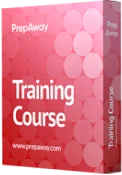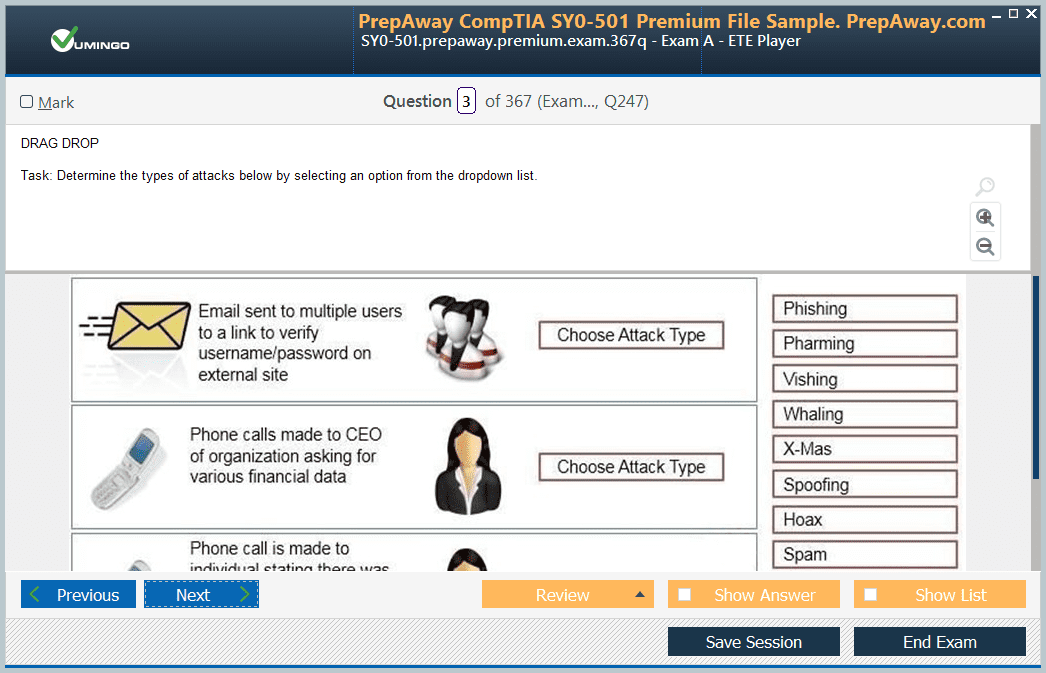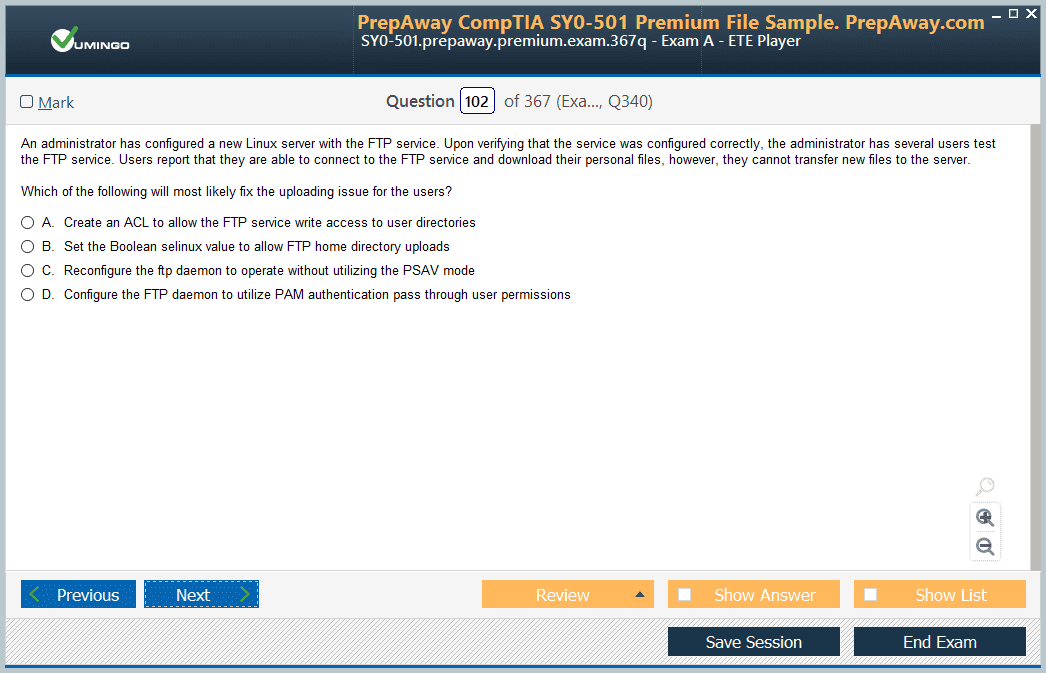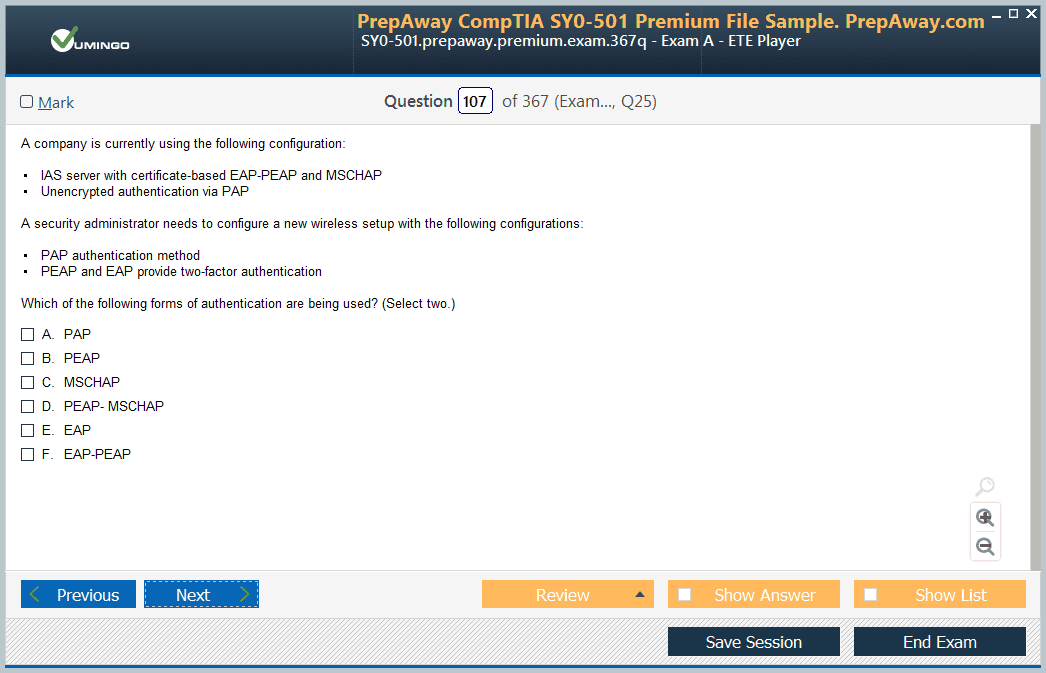- Home
- Amazon Certifications
- AWS Certified Security - Specialty SCS-C02 AWS Certified Security - Specialty SCS-C02 Dumps
Pass Amazon AWS Certified Security - Specialty SCS-C02 Exam in First Attempt Guaranteed!
Get 100% Latest Exam Questions, Accurate & Verified Answers to Pass the Actual Exam!
30 Days Free Updates, Instant Download!


AWS Certified Security - Specialty SCS-C02 Premium Bundle
- Premium File 308 Questions & Answers. Last update: Jan 07, 2026
- Training Course 249 Video Lectures
- Study Guide 865 Pages
Last Week Results!

Includes question types found on the actual exam such as drag and drop, simulation, type-in and fill-in-the-blank.

Based on real-life scenarios similar to those encountered in the exam, allowing you to learn by working with real equipment.

Developed by IT experts who have passed the exam in the past. Covers in-depth knowledge required for exam preparation.
All Amazon AWS Certified Security - Specialty SCS-C02 certification exam dumps, study guide, training courses are Prepared by industry experts. PrepAway's ETE files povide the AWS Certified Security - Specialty SCS-C02 AWS Certified Security - Specialty SCS-C02 practice test questions and answers & exam dumps, study guide and training courses help you study and pass hassle-free!
SCS-C02 in Focus: Core Principles Every Security Specialist Should Know
The AWS Certified Security – Specialty certification, in its revised version released, focuses on validating advanced knowledge in securing the AWS ecosystem. The updated exam (SCS-C02) reflects the evolving threat landscape and the increasing complexity of cloud environments. It includes revised domains that emphasize hands-on expertise and current best practices in securing AWS infrastructure and services.
This certification is suited for professionals aiming to deepen their understanding of how security controls are implemented across identity, infrastructure, data, and detection mechanisms in the AWS environment. While the scope remains security-centric, it now includes deeper coverage of hybrid architectures, fine-grained access control mechanisms, and automated threat response practices.
Key Domains That Define The SCS-C02 Blueprint
The updated structure of the exam breaks down the topics into well-distributed domains, ensuring candidates demonstrate technical proficiency, architectural awareness, and real-time response capabilities. The core domains include:
Threat Detection And Incident Response
This domain tests the candidate’s ability to configure and manage services that allow continuous monitoring, logging, and threat detection. Proficiency in setting up centralized log aggregation, analyzing alerts, fine-tuning security events, and correlating activity across multiple services is essential.
Expect a strong focus on automated response workflows. These require fluency in constructing playbooks that define triggers, such as suspicious IAM activity, and associating those with automated remediation actions that use services like serverless compute or container orchestration.
Security Logging And Monitoring
Security monitoring strategies on AWS go beyond basic logging. Candidates are expected to understand architectural patterns that ensure audit readiness and reduce visibility gaps. The emphasis is on configuring robust centralized log pipelines that scale with multiple accounts and environments.
Another critical aspect includes implementing lifecycle policies for logs, ensuring logs are immutable, encrypted, and retained in alignment with compliance mandates. There’s also emphasis on integrating custom metrics and dashboards that combine various telemetry signals for holistic threat insight.
Infrastructure Security
In this section, candidates are evaluated on their ability to implement layered security controls across compute, networking, and storage. This includes enforcing segmentation at the VPC level using network access control lists, route configurations, and endpoint security.
It also examines workload hardening through patch management automation, host-based intrusion detection systems, and vulnerability scanning strategies. Knowing how to design scalable bastionless architectures, apply advanced routing techniques, and enforce identity-aware perimeter protections becomes essential.
Identity And Access Management
One of the most in-depth areas in the exam, identity control mechanisms now span across federated identity, temporary credential usage, permission boundaries, session policies, and fine-grained resource-level access.
This domain demands a practical grasp of role chaining, condition keys, cross-account delegation, and enforcement of least privilege through permission inspection tools. Candidates must demonstrate how to manage identity propagation in hybrid and multi-account environments while minimizing blast radius.
Data Protection
This domain focuses on securing data at rest, in transit, and in use. Candidates are expected to be familiar with key management strategies, envelope encryption mechanisms, tokenization, and secret rotation practices.
Additionally, understanding data classification, automated data discovery, and integrating encryption workflows into application layers becomes a distinguishing capability. Protecting sensitive data in edge workloads, regional workloads, and analytics services rounds out this domain
The Structure Of A High-Impact Study Plan
A successful study approach for this certification relies on a structured and iterative method. One effective method consists of dividing preparation into phases that alternate between deep theoretical absorption and active recall.
Phase 1: Foundation Building With Video And Documentation
A practical approach to understanding the updated objectives starts by reviewing content mapped directly to the five domains. During this phase, it's essential to:
Focus on core architectural concepts behind each domain
Use whiteboarding to sketch out data flow diagrams, IAM trust relationships, and logging pipelines
Maintain a glossary of key terminology and service features
Track recent changes in services, especially those related to encryption, logging granularity, and access management
This builds a mental framework, allowing you to comprehend rather than memorize.
Phase 2: Scenario-Based Reinforcement
After foundational study, transition into scenario-based analysis. Practice by solving real-world case studies or questions that force you to:
Evaluate a multi-layered security challenge
Choose the most effective and cost-efficient combination of services
Explain the rationale behind the chosen solution
Point out potential security gaps in the alternative options
This develops your intuition and readiness for complex exam scenarios that require both logic and knowledge.
Establishing Real-World Context Through Hands-On Labs
Theory alone is insufficient for this exam. What sets high performers apart is their ability to simulate real environments and test security strategies in live accounts. Key areas to explore hands-on include:
Building secure VPCs with public and private subnets, NAT gateways, and VPN tunnels
Implementing cross-region replication with custom key management
Creating multi-account access policies using organizations and service control policies
Running analytics pipelines with security constraints, such as column-level encryption
Testing alerting workflows and remediation via event-driven compute
Hands-on learning ensures concepts are not only understood but also retained and contextualized.
Learning From Mistakes During Practice Exams
One crucial component of exam readiness is deliberate practice with high-quality exam simulations. The key isn’t just answering questions, but developing meta-cognition — the ability to understand why an answer is right or wrong.
After each practice test, review every incorrect or guessed answer, even if it was correct. For each, ask:
Was my logic flawed or was I unfamiliar with a service behavior?
Was I tricked by a distractor that included partially correct but incomplete information?
Did I misread the requirements — e.g., choosing the most cost-effective option when the question asked for highest availability?
This builds test literacy and reduces the likelihood of cognitive traps during the real exam.
Advanced Techniques For Mastery
To go beyond exam-focused learning and truly absorb cloud security principles, introduce techniques such as:
Flashcard-driven active recall on topics like policy evaluation logic, log format identifiers, or key rotation intervals
Teaching the material to others, which forces deeper clarity and reveals gaps
Using real-time architectural scenario tools to sketch and annotate security models
Maintaining a progress journal that tracks topics you’ve mastered, misunderstood, or need to revisit
These techniques help embed the material deeply into long-term memory and improve adaptability under pressure.
Understanding Layered Security In Cloud Architecture
Security architecture in the cloud follows the principle of layered defense. Each layer of the cloud stack must be evaluated for risk exposure and secured accordingly. From perimeter-level controls to data-layer protections, layered security ensures that a compromise in one layer does not expose the entire environment.
At the network level, segmentation strategies such as private subnets, routing filters, and endpoint restrictions are crucial. Designing isolated virtual networks, integrating secure gateways, and enforcing boundary controls help reduce exposure. Security groups and routing policies should align with least privilege networking.
At the compute level, resources must be hardened. That includes using minimal base images, applying patches automatically, managing secrets securely, and assigning scoped roles. Compute isolation through virtual machines, containers, and serverless frameworks plays a significant role in reducing lateral movement.
Designing Secure Identity Management Strategies
Identity is central to cloud security. The SCS-C02 exam evaluates how well candidates design and enforce identity policies using built-in AWS identity services. Identity and access management must be implemented with clarity, precision, and minimal exposure.
Cross-account access should rely on tightly scoped roles with assumed identity tokens, not long-lived credentials. Role chaining and delegation are essential for managing access across multi-account architectures. Permission boundaries allow delegation of access without compromising overall policy control.
Organizational-level policies must enforce consistent access guardrails. This includes service control policies to prevent escalation or misconfiguration across account boundaries. Attribute-based access control provides a more scalable and dynamic method of assigning permissions based on user or resource tags.
Integrating Data Protection Into Architecture
Protecting sensitive data is one of the most heavily emphasized areas in the SCS-C02 exam. This involves planning encryption, storage policies, access control, and lifecycle protections. Encryption must be implemented at rest, in transit, and optionally in use.
Encryption should be driven by centralized key management, with proper segregation between users and systems that create, use, and administer the keys. Policies should enforce encryption at upload and decrypt only for approved workflows. Rotating keys regularly and enabling key usage logging helps track access and ensure compliance.
Storage policies should restrict public access, apply retention controls, and limit administrative access. Sensitive data classification and tagging improve automation and help security teams monitor high-risk objects more effectively. Isolation of data by workload, tenant, or compliance domain is also encouraged.
Logging And Monitoring As Design Patterns
Observability is essential to detecting threats and understanding the security state of a cloud environment. The SCS-C02 exam includes advanced questions around log centralization, event correlation, and alerting logic. Logging must be reliable, tamper-proof, and aligned with compliance standards.
Designs should include log pipelines that collect data from compute, storage, networking, identity, and service access points. Logs must be encrypted in transit and at rest. Long-term retention should be implemented for audits and historical analysis.
Security events need to be integrated into alerting systems that trigger automation. For example, alerts for policy violations or abnormal access attempts should result in immediate notifications or automated remediation. Architectures must support the scaling of log analysis, without introducing performance or cost issues.
Compliance-Aware Architectural Decisions
The updated SCS-C02 exam evaluates how candidates build security architectures that also support compliance. This means understanding regional data handling laws, retention requirements, encryption mandates, and incident reporting timelines.
Workloads must be segmented by compliance domain. This may involve deploying separate environments for regulated data, using resource tagging to enforce compliance policies, and maintaining audit trails for every access event.
Monitoring tools should track changes to compliance-related settings and flag non-compliant configurations. Automation can enforce security baselines using configuration management and policy templates. Continuous compliance assessment becomes a built-in part of the architecture.
Advanced Scenarios Tested In Design Questions
The SCS-C02 certification often tests your ability to build or analyze architectures based on limited information and conflicting constraints. You may be presented with scenarios involving legacy systems, hybrid connectivity, misconfigured permissions, or underprotected workloads.
Candidates must identify root causes and design mitigation strategies that address the issue without introducing new risks. Trade-offs between cost, complexity, and security posture must be considered. Some questions may also involve adapting security patterns to disaster recovery, continuous delivery, or decentralized environments.
The ability to interpret requirements from both a business and technical angle is essential. Understanding context helps determine when to prioritize encryption, isolate environments, implement real-time monitoring, or enforce stricter access policies.
Embedding Security Into Development And Deployment Pipelines
Security must be integrated into every stage of application development and deployment. Designing a secure pipeline involves setting up continuous security checks, static and dynamic code analysis, and automated remediation for policy violations.
Infrastructure as code should include embedded security controls such as role-based access, restricted ingress rules, and encryption enforcement. Deployment gates should prevent insecure configurations from being pushed into production.
Role separation must be clear. Developers, security engineers, and operators must have distinct permissions, and every change must be traceable. Logs from pipeline activity help ensure accountability and audit readiness.
Automated tools can scan for vulnerabilities in code or container images, block known threats, and provide policy enforcement. This proactive approach helps prevent misconfigurations and security flaws from being introduced during the software delivery process.
Visualizing Architecture For Exam Preparation
Building a visual mental model of cloud security architecture is key to retaining concepts and performing under exam conditions. Sketching out secure deployments helps clarify service interactions, trust boundaries, and control enforcement points.
Candidates are encouraged to create diagrams for scenarios such as multi-region disaster recovery, federated identity management, centralized log analysis, and encrypted data storage. Annotating these diagrams with service-level policies, traffic flow, and access restrictions strengthens understanding.
This visualization technique aids in pattern recognition, which is useful when solving complex architecture-based questions under time constraints.
Building A Foundation For Threat Detection
Threat detection in cloud environments involves collecting signals from across the infrastructure and interpreting them to identify malicious activity. A key skill tested in the SCS-C02 exam is configuring native threat detection services and integrating them into centralized workflows.
A strong detection strategy begins with identifying the types of threats relevant to your environment. These may include unauthorized access attempts, privilege escalation, exposed secrets, data exfiltration, and lateral movement between services. Each of these threats leaves traces in logs, metrics, and behavior anomalies.
Candidates are expected to understand how to configure detection services to recognize these patterns and escalate them appropriately. Detection must also consider the context of the workload, the criticality of the resource, and the potential business impact.
Designing Centralized Security Monitoring
Monitoring cloud environments efficiently requires a centralized architecture that aggregates data from multiple sources and accounts. This architecture must be designed to scale, support real-time queries, and provide secure access to authorized personnel.
Log aggregation should cover all critical areas, including identity and access events, resource configuration changes, network activity, and data access logs. Logs must be encrypted, timestamped, and retained according to policy.
Monitoring dashboards should provide visual summaries of activity and allow filtering based on account, region, or event type. Role-based access control ensures that only authorized users can view or analyze sensitive logs.
Alerting mechanisms should be linked to monitoring tools. This includes setting thresholds for failed login attempts, anomaly detection based on baselines, and detection of deviations in resource configurations. Each alert must be actionable and traceable.
Automating Incident Response Workflows
In modern cloud environments, manual incident response is often too slow and prone to error. The SCS-C02 exam evaluates your ability to design automated workflows that respond to threats in a timely and consistent manner.
Incident response begins with detection. Once a suspicious event is identified, it must trigger a sequence of actions that contain the incident, investigate the root cause, and prevent recurrence. This requires defining incident playbooks that specify conditions, triggers, actions, and rollback procedures.
Common automated responses include disabling compromised credentials, isolating affected compute instances, revoking access keys, or notifying teams through secure communication channels. These responses must be implemented with proper permissions and fail-safe mechanisms to avoid disruptions.
Candidates should understand how to link detection services with automation frameworks. This includes defining event rules, using serverless functions for execution, and storing response metadata for auditing.
Implementing Forensics And Investigation Strategies
Forensics is a critical part of incident response. It involves preserving evidence, identifying root causes, and documenting the sequence of events for review and compliance. The SCS-C02 exam tests your knowledge of building systems that support post-incident analysis.
Logs must be stored in a tamper-proof location, and backups must be taken before any remediation actions. Snapshotting storage volumes, collecting memory dumps, and exporting resource configurations are examples of preserving evidence.
During investigation, timelines must be reconstructed based on authentication events, resource changes, and user actions. Each step must be mapped to the systems affected and the controls in place.
Documentation is essential. Investigations should result in detailed reports that summarize the attack vector, security gaps exploited, actions taken, and recommendations for improvement.
Detecting Insider Threats And Anomalies
Insider threats are particularly difficult to detect because they originate from trusted identities. The SCS-C02 exam includes questions related to anomaly detection, behavioral analysis, and the use of contextual data to identify insider risks.
Candidates must understand how to baseline normal behavior for users and services. Deviations from these baselines, such as accessing unusual resources, logging in from unfamiliar locations, or modifying high-risk configurations, can indicate malicious activity.
Anomaly detection can be rule-based or machine learning-based. Both approaches rely on continuous monitoring and statistical analysis. Candidates should know how to configure detection engines, train models, and refine thresholds to reduce false positives.
Detection should also consider the privilege level of the user. Anomalous behavior from an administrative identity should trigger higher severity alerts than similar behavior from a low-privilege role.
Integrating Third-Party Intelligence And Correlation
Threat intelligence provides external context that enhances detection and response capabilities. It includes data such as known malicious IP addresses, malware signatures, and indicators of compromise. The SCS-C02 exam evaluates your ability to integrate threat intelligence feeds into detection systems.
Correlation engines can use this intelligence to flag connections to suspicious domains, detect communication with compromised systems, or identify use of outdated protocols known to be vulnerable.
Integrating external threat feeds requires configuring ingestion points, mapping indicators to detection rules, and maintaining up-to-date threat databases. Intelligence must be contextualized to avoid irrelevant alerts and maintain signal quality.
Threat correlation also applies to internal data. Linking log events, access requests, and configuration changes helps build a complete picture of an incident and identify patterns that point to broader threats.
Operationalizing Security Monitoring For Scale
As environments grow, monitoring must evolve to handle larger volumes of data without reducing visibility. This requires designing scalable logging pipelines, decoupling ingestion from analysis, and optimizing storage.
Candidates should understand how to use data partitioning, indexing, and filtering to ensure fast access to critical logs. Cost optimization is also a consideration, as high-volume environments can generate significant logging expenses.
Monitoring systems should include health checks, redundancy, and recovery plans. This ensures that in case of a system failure, security monitoring remains uninterrupted. Performance baselines should be established to detect when systems are overloaded or under attack.
Security operations must be treated as a continuous process. Monitoring configurations should be reviewed regularly, and alerts should be refined based on incident history and evolving threats.
Preparing For Detection And Response Questions In The Exam
Questions related to threat detection and response often include scenario-based problems. You may be asked to identify why a certain threat was not detected, how to improve visibility, or what steps should be taken during an incident.
To prepare, candidates should study real-world attack simulations and understand how cloud-native services behave during those scenarios. It is important to recognize log patterns, configure alert conditions, and build logical workflows that lead from detection to resolution.
Exam scenarios will test both technical skill and judgment. Knowing what to detect is as important as knowing how to respond.
Understanding Data Sensitivity And Classification
A key aspect of data protection is the correct classification of data based on sensitivity, regulatory requirements, and business impact. Proper classification enables targeted security controls and ensures that high-risk data is always handled with the appropriate level of protection.
Data classification strategies should be automated wherever possible. Labels and tags can be used to define data types such as confidential, internal use, or public. This allows systems to apply specific encryption, access control, and retention policies automatically.
The SCS-C02 exam tests the ability to align classification with access policies. For example, only specific roles should access confidential data, and such access must be logged and reviewed regularly. Understanding how to automate these rules within services and across environments is critical.
Securing Data At Rest, In Transit, And In Use
Data security involves protecting information at every stage of its lifecycle. Encryption is foundational but must be paired with access control, monitoring, and data handling best practices.
For data at rest, encryption must be enforced using customer-managed keys where higher control is required. Access to keys must be tightly controlled, logged, and periodically rotated. Data must also be stored in secure locations with access based on role, network location, and business requirement.
For data in transit, encrypted communication protocols should be the default. Secure connections must be enforced between services, devices, and users. It is also essential to verify that traffic is not downgraded or redirected by unauthorized actors.
Data in use presents unique challenges. The goal is to reduce the time and surface area where unencrypted data is accessible. Strategies include minimizing access scope, using ephemeral storage, and isolating sensitive processing workloads.
Implementing Key Management At Scale
Managing encryption keys is a critical responsibility. Poor key management can lead to data breaches or regulatory violations. The SCS-C02 exam includes scenarios that test the ability to configure key lifecycle policies, enforce rotation, and audit usage.
Key policies must define who can use, manage, or delete keys. Separation of duties ensures that no single user has unchecked control. Key rotation should be automatic for frequently used keys and manual only when operationally justified.
Access logs must be reviewed to ensure keys are not being used outside of expected patterns. Key usage should be monitored across accounts and services to identify potential misuse or anomalies.
Candidates must also understand how to integrate key management into larger security architectures. This includes supporting multi-region redundancy, automated failover, and compliance with regional encryption standards.
Designing Governance With Security Controls
Governance involves the structures, policies, and practices that ensure security objectives are consistently met across the organization. It defines how responsibilities are distributed, how access is granted, and how compliance is measured.
Governance begins with identity and resource management. Organizations should define clear ownership of resources, consistent naming conventions, and tagging standards. Policies must enforce account boundaries, usage limits, and configuration baselines.
Auditing and compliance tools should be used to detect deviation from approved configurations. Dashboards should show real-time status of security controls, helping teams act quickly when standards are violated.
Security governance must also address change management. Infrastructure and code changes must go through approval workflows that include security review, testing, and logging. This ensures traceability and accountability.
Enforcing Compliance Requirements In Cloud Environments
Many organizations must comply with regional or industry-specific regulations. This includes handling data according to privacy laws, storing records for audit purposes, and proving access controls are in place.
The SCS-C02 exam evaluates your ability to align cloud configurations with these regulations. This includes restricting data residency to specific regions, enforcing logging retention, encrypting regulated data, and applying service-specific compliance templates.
Understanding the shared responsibility model is essential. Candidates must identify which security controls are managed by the cloud provider and which must be implemented by the customer. Responsibilities must be clearly defined in the architecture.
Compliance automation plays a major role. It reduces manual overhead and ensures policies are applied consistently. Organizations should use tools that detect configuration drift, enforce baselines, and provide reports for audits.
Designing Data Recovery And Business Continuity Plans
Security includes preparing for failure. Business continuity and disaster recovery plans are critical components of a secure architecture. The SCS-C02 exam requires knowledge of data backup, system failover, and minimal recovery point and time objectives.
Backup policies must consider encryption, redundancy, and geographical separation. Recovery plans should be tested periodically to validate their effectiveness. Failover systems must be ready to assume operation with minimal manual intervention.
Designing resilient systems also means isolating dependencies, using fault-tolerant infrastructure, and implementing retry mechanisms. Security must be built into these processes to prevent data loss or corruption during recovery events.
Candidates should know how to architect solutions that preserve confidentiality and integrity even during failover. These include secure key recovery procedures, encrypted backup storage, and access controls during recovery events.
Maintaining Security As An Ongoing Process
Security is not a one-time effort but a continuous discipline. Organizations must constantly adapt to new threats, update their defenses, and refine their policies. The SCS-C02 exam acknowledges this by emphasizing security lifecycle management.
Security reviews must be scheduled regularly. This includes reviewing access permissions, scanning for misconfigurations, and evaluating the effectiveness of monitoring systems. Findings must be documented and tracked until resolved.
Training and awareness programs must ensure all stakeholders understand their responsibilities. Developers, analysts, administrators, and auditors must all contribute to the organization’s security posture.
Security operations should be agile and responsive. Change detection, anomaly analysis, and real-time remediation must be part of the normal workflow. Governance must allow for innovation while maintaining control.
Final Words
Preparing for the SCS-C02 certification requires more than just familiarity with cloud security concepts. It demands a methodical, hands-on, and practical approach to understand the nuances of AWS's security architecture and how to apply it across various scenarios. From identity management and network protection to incident response and data classification, each domain of the exam is designed to test depth, clarity, and precision of your security knowledge.
Spending time understanding foundational AWS services such as IAM, KMS, CloudTrail, GuardDuty, Security Hub, and Config will pay off significantly. These are not just exam topics but essential components of real-world cloud security. The key to mastering them lies in consistent practice, simulating real-world scenarios, and understanding how services interact in complex deployments.
Use your study time strategically. Don't just memorize features; understand why and how they are used. Focus on the purpose and integration of each security control and how to apply it effectively in the context of threat modeling and risk reduction. Consider working through high-fidelity practice exams and deeply analyzing incorrect responses to fill your knowledge gaps. The ability to connect theory with hands-on implementation is what transforms a good candidate into a certified security professional.
This certification is not just a badge—it represents your capability to design, implement, and operate secure AWS workloads. With a disciplined and thoughtful study approach, passing the SCS-C02 exam can be an achievable goal that adds real value to your professional journey
Amazon AWS Certified Security - Specialty SCS-C02 practice test questions and answers, training course, study guide are uploaded in ETE Files format by real users. Study and Pass AWS Certified Security - Specialty SCS-C02 AWS Certified Security - Specialty SCS-C02 certification exam dumps & practice test questions and answers are to help students.
- AWS Certified Solutions Architect - Associate SAA-C03
- AWS Certified Solutions Architect - Professional SAP-C02
- AWS Certified AI Practitioner AIF-C01
- AWS Certified Cloud Practitioner CLF-C02
- AWS Certified Machine Learning Engineer - Associate MLA-C01
- AWS Certified DevOps Engineer - Professional DOP-C02
- AWS Certified Data Engineer - Associate DEA-C01
- AWS Certified Security - Specialty SCS-C02
- AWS Certified Advanced Networking - Specialty ANS-C01
- AWS Certified Developer - Associate DVA-C02
- AWS Certified Machine Learning - Specialty - AWS Certified Machine Learning - Specialty (MLS-C01)
- AWS Certified CloudOps Engineer - Associate SOA-C03
- AWS Certified SysOps Administrator - Associate - AWS Certified SysOps Administrator - Associate (SOA-C02)
- AWS-SysOps - AWS Certified SysOps Administrator (SOA-C01)
Purchase AWS Certified Security - Specialty SCS-C02 Exam Training Products Individually



Why customers love us?
What do our customers say?
The resources provided for the Amazon certification exam were exceptional. The exam dumps and video courses offered clear and concise explanations of each topic. I felt thoroughly prepared for the AWS Certified Security - Specialty SCS-C02 test and passed with ease.
Studying for the Amazon certification exam was a breeze with the comprehensive materials from this site. The detailed study guides and accurate exam dumps helped me understand every concept. I aced the AWS Certified Security - Specialty SCS-C02 exam on my first try!
I was impressed with the quality of the AWS Certified Security - Specialty SCS-C02 preparation materials for the Amazon certification exam. The video courses were engaging, and the study guides covered all the essential topics. These resources made a significant difference in my study routine and overall performance. I went into the exam feeling confident and well-prepared.
The AWS Certified Security - Specialty SCS-C02 materials for the Amazon certification exam were invaluable. They provided detailed, concise explanations for each topic, helping me grasp the entire syllabus. After studying with these resources, I was able to tackle the final test questions confidently and successfully.
Thanks to the comprehensive study guides and video courses, I aced the AWS Certified Security - Specialty SCS-C02 exam. The exam dumps were spot on and helped me understand the types of questions to expect. The certification exam was much less intimidating thanks to their excellent prep materials. So, I highly recommend their services for anyone preparing for this certification exam.
Achieving my Amazon certification was a seamless experience. The detailed study guide and practice questions ensured I was fully prepared for AWS Certified Security - Specialty SCS-C02. The customer support was responsive and helpful throughout my journey. Highly recommend their services for anyone preparing for their certification test.
I couldn't be happier with my certification results! The study materials were comprehensive and easy to understand, making my preparation for the AWS Certified Security - Specialty SCS-C02 stress-free. Using these resources, I was able to pass my exam on the first attempt. They are a must-have for anyone serious about advancing their career.
The practice exams were incredibly helpful in familiarizing me with the actual test format. I felt confident and well-prepared going into my AWS Certified Security - Specialty SCS-C02 certification exam. The support and guidance provided were top-notch. I couldn't have obtained my Amazon certification without these amazing tools!
The materials provided for the AWS Certified Security - Specialty SCS-C02 were comprehensive and very well-structured. The practice tests were particularly useful in building my confidence and understanding the exam format. After using these materials, I felt well-prepared and was able to solve all the questions on the final test with ease. Passing the certification exam was a huge relief! I feel much more competent in my role. Thank you!
The certification prep was excellent. The content was up-to-date and aligned perfectly with the exam requirements. I appreciated the clear explanations and real-world examples that made complex topics easier to grasp. I passed AWS Certified Security - Specialty SCS-C02 successfully. It was a game-changer for my career in IT!












